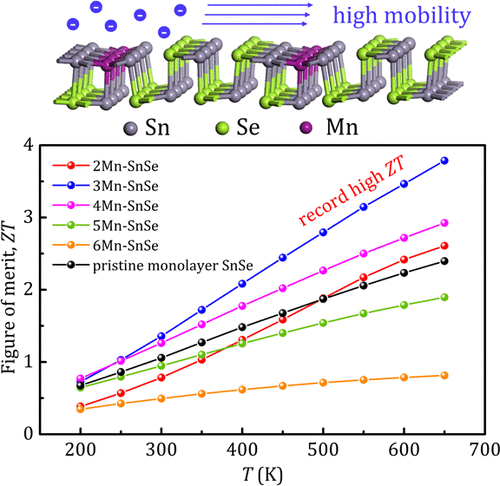当前位置:
X-MOL 学术
›
ACS Appl. Energy Mater.
›
论文详情
Our official English website, www.x-mol.net, welcomes your
feedback! (Note: you will need to create a separate account there.)
Two-Dimensional SnSe Composited with One-Dimensional Mn Nanowires: A Promising Thermoelectric with Ultrahigh Power Factor
ACS Applied Energy Materials ( IF 5.4 ) Pub Date : 2020-08-26 , DOI: 10.1021/acsaem.0c01591
Y. F. Li 1 , G. H. Tang 1 , Bo Fu 1 , Min Zhang 1 , Xin Zhao 1
ACS Applied Energy Materials ( IF 5.4 ) Pub Date : 2020-08-26 , DOI: 10.1021/acsaem.0c01591
Y. F. Li 1 , G. H. Tang 1 , Bo Fu 1 , Min Zhang 1 , Xin Zhao 1
Affiliation

|
Two-dimensional (2D) SnSe is a promising candidate for thermoelectric applications. In this work, we have explored an optimization strategy for thermoelectric conversion in two-dimensional monolayer SnSe by compositing with one-dimensional (1D) Mn nanowires. The thermoelectric properties were investigated using the first-principles theory calculation combined with the Boltzmann transport theory. The proposed 2D–1D composite structure can regulate the band gap and the degeneracy by changing the distance between 1D Mn nanowires. It was found that the carrier mobility can be increased to a maximum of 8143.26 cm2 V–1 s–1 at 300 K due to the reduced electron–phonon scattering effect. In addition, high band degeneracy and high carrier mobility lead to an ultrahigh power factor of 200 μW cm–1 K–2 in 3Mn–SnSe at 300 K, which can compensate for the negative effect of high electronic thermal conductivity. As a result, record high ZT values from 0.73 at 200 K to 3.78 at 650 K are achieved in 3Mn–SnSe, 39.2% larger than the ZT values of the pristine monolayer SnSe on average. This work presents an effective structural modification strategy to optimize the thermoelectric performance of 2D SnSe, with the potential of extension to other low-dimensional thermoelectric materials.
中文翻译:

一维锰纳米线复合二维锡硒:一种超高功率因数的有前途的热电
二维(2D)SnSe是热电应用的有希望的候选者。在这项工作中,我们通过与一维(1D)Mn纳米线复合,探索了二维单层SnSe中热电转换的优化策略。利用第一性原理计算和玻尔兹曼输运理论对热电性质进行了研究。提出的2D–1D复合结构可以通过改变一维Mn纳米线之间的距离来调节带隙和简并性。发现载流子迁移率可以增加到最大8143.26 cm 2 V –1 s –1由于减少了声子的电子声子散射效应,在300 K的温度下。此外,高频带简并性和高载流子迁移率导致300 K的3Mn–SnSe中具有200μWcm –1 K –2的超高功率因数,可以补偿高电子热导率的负面影响。结果,在3Mn–SnSe中获得了创纪录的ZT值,从200 K的0.73到650 K的3.78,比原始的单层SnSe的ZT值平均大39.2%。这项工作提出了一种有效的结构修改策略,以优化2D SnSe的热电性能,并具有扩展到其他低维热电材料的潜力。
更新日期:2020-09-28
中文翻译:

一维锰纳米线复合二维锡硒:一种超高功率因数的有前途的热电
二维(2D)SnSe是热电应用的有希望的候选者。在这项工作中,我们通过与一维(1D)Mn纳米线复合,探索了二维单层SnSe中热电转换的优化策略。利用第一性原理计算和玻尔兹曼输运理论对热电性质进行了研究。提出的2D–1D复合结构可以通过改变一维Mn纳米线之间的距离来调节带隙和简并性。发现载流子迁移率可以增加到最大8143.26 cm 2 V –1 s –1由于减少了声子的电子声子散射效应,在300 K的温度下。此外,高频带简并性和高载流子迁移率导致300 K的3Mn–SnSe中具有200μWcm –1 K –2的超高功率因数,可以补偿高电子热导率的负面影响。结果,在3Mn–SnSe中获得了创纪录的ZT值,从200 K的0.73到650 K的3.78,比原始的单层SnSe的ZT值平均大39.2%。这项工作提出了一种有效的结构修改策略,以优化2D SnSe的热电性能,并具有扩展到其他低维热电材料的潜力。

































 京公网安备 11010802027423号
京公网安备 11010802027423号